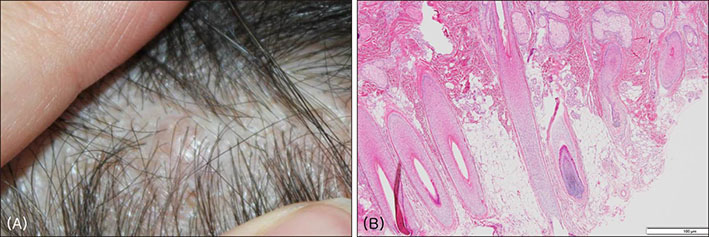Ann Dermatol.
2018 Dec;30(6):701-703. 10.5021/ad.2018.30.6.701.
Lipedematous Alopecia in an Asian Woman: Is It an Advanced Stage of Lipedematous Scalp?
- Affiliations
-
- 1Department of Dermatology, Chung-Ang University College of Medicine, Seoul, Korea.
- 2Department of Dermatology, H Plus Yangji Hospital, Seoul, Korea. hongck@cau.ac.kr
- KMID: 2428926
- DOI: http://doi.org/10.5021/ad.2018.30.6.701
Abstract
- Lipedematous alopecia (LA) is a rare disease entity that manifests as increased thickness of subcutaneous fatty tissue in the scalp with a variable degree of acquired, non-scarring alopecia. Although the pathogenesis of alopecia in LA is not clear, it is assumed that the increased thickness of subcutaneous fat retards hair growth by disturbing the peripheral microenvironment of the hair bulb. LA is clinically distinguishable from lipedematous scalp (LS) in that LS is not associated with any hair abnormalities, while LA is characterized by variable degree of hair loss. However, both LA and LS share increased scalp thickness. Here, we describe a rare case of LA on the frontal scalp of an Asian woman, further characterize the clinical and histologic features, and suggest applying an integrated diagnosis as lipedematous diseases of the scalp.
MeSH Terms
Figure
Reference
-
1. González-Guerra E, Haro R, Angulo J, Del Carmen Fariña M, Martín L, Requena L. Lipedematous alopecia: an uncommon clinicopathologic variant of nonscarring but permanent alopecia. Int J Dermatol. 2008; 47:605–609.
Article2. Coskey RJ, Fosnaugh RP, Fine G. Lipedematous alopecia. Arch Dermatol. 1961; 84:619–622.
Article3. Curtis JW, Heising RA. Lipedematous alopecia associated with skin hyperelasticity. Arch Dermatol. 1964; 89:819–820.
Article4. Martín JM, Monteagudo C, Montesinos E, Guijarro J, Llombart B, Jordá E. Lipedematous scalp and lipedematous alopecia: a clinical and histologic analysis of 3 cases. J Am Acad Dermatol. 2005; 52:152–156.
Article5. Bukhari I, Al Mulhim F, Al Hoqail R. Hyperlipidemia and lipedematous scalp. Ann Saudi Med. 2004; 24:484–485.
Article6. Garn SM, Selby S, Young R. Scalp thickness and the fat-loss theory of balding. AMA Arch Derm Syphilol. 1954; 70:601–608.
Article7. Yip L, Mason G, Pohl M, Sinclair R. Successful surgical management of lipoedematous alopecia. Australas J Dermatol. 2008; 49:52–54.
Article8. Yasar S, Gunes P, Serdar ZA, Tosun I. Clinical and pathological features of 31 cases of lipedematous scalp and lipedematous alopecia. Eur J Dermatol. 2011; 21:520–528.
Article9. Müller CS, Niclou M, Vogt T, Pföhler C. Lipedematous diseases of the scalp are not separate entities but part of a spectrum of lipomatous lesions. J Dtsch Dermatol Ges. 2012; 10:501–507.
Article10. Busetto L, Sträter D, Enzi G, Coin A, Sergi G, Inelmen EM, et al. Differential clinical expression of multiple symmetric lipomatosis in men and women. Int J Obes Relat Metab Disord. 2003; 27:1419–1422.
Article11. Kratz C, Lenard HG, Ruzicka T, Gärtner J. Multiple symmetric lipomatosis: an unusual cause of childhood obesity and mental retardation. Eur J Paediatr Neurol. 2000; 4:63–67.
Article12. Yasar S, Mansur AT, Göktay F, Sungurlu F, Vardar Aker F, Ozkara S. Lipedematous scalp and lipedematous alopecia: report of three cases in white adults. J Dermatol. 2007; 34:124–130.
Article
- Full Text Links
- Actions
-
Cited
- CITED
-
- Close
- Share
- Similar articles
-
- A Congenitally Inherited Case of Lipedematous Scalp Involving the Entire Scalp
- Congenital Lipedematous Alopecia: Adding to the Differential Diagnosis of Congenital Alopecia
- Two Cases of Lipedematous Scalp in Korean Patients
- A Case of Diffuse Alopecia Induced by Syringoma
- Alopecia Neoplastica due to Gastric Adenocarcinoma Metastasis to the Scalp, Presenting as Alopecia: A Case Report and Literature Review


